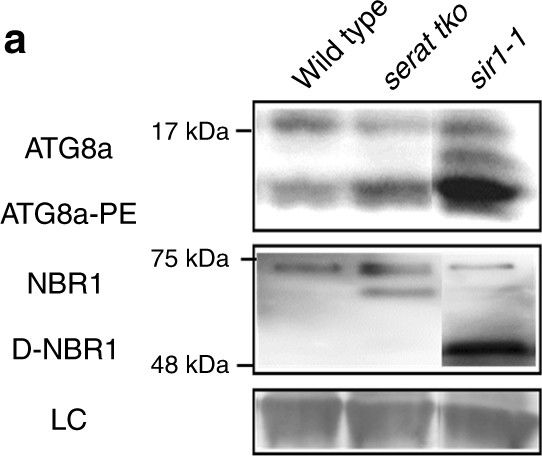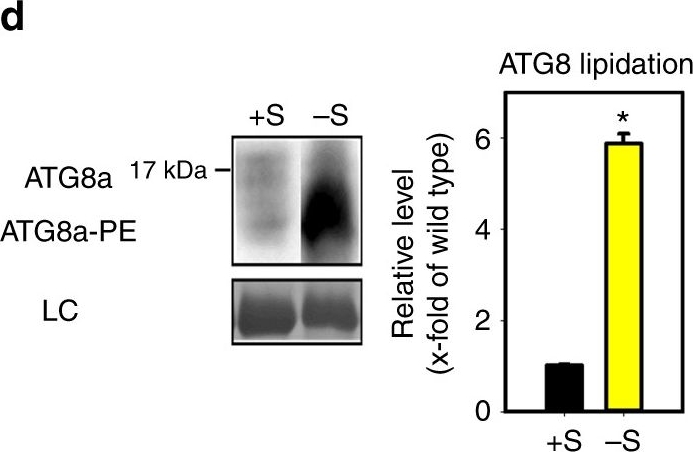1

Anti-ATG8A-I | Autophagy-related protein 8A-I isoforms
AS14 2811 | Clonality: Polyclonal | Host: Rabbit | Reactivity: Arabidopsis thaliana, Oryza sativa
- Product Info
-
Immunogen: Part of recombinant ATG8A from Arabidopsis thaliana, UniProt:Q8LEM4,TAIR:AT4G21980 Host: Rabbit Clonality: Polyclonal Purity: Serum Format: Lyophilized Quantity: 50 µl Reconstitution: For reconstitution add 50 µl of sterile water Storage: Store lyophilized/reconstituted at -20°C; once reconstituted make aliquots to avoid repeated freeze-thaw cycles. Please remember to spin the tubes briefly prior to opening them to avoid any losses that might occur from material adhering to the cap or sides of the tube. Tested applications: Western blot (WB), Immunogold (IG) Recommended dilution: 1 :4000 (WB) Expected | apparent MW: 13.6 kDa - Reactivity
-
Confirmed reactivity: Recombinant ATG8 A-I of Arabidopsis thaliana, Oryza sativa Predicted reactivity: Species of your interest not listed? Contact us Not reactive in: No confirmed exceptions from predicted reactivity are currently known - Application Examples
-
Application example 
2 µg of respective recombinant Arabidopsis thaliana ATG8 isoform, denatured at 95C for 2 min. were separated on % SDS-PAGE and blotted 1h to nitrocellulose (GE10600003) using semi-dry transfer. Blots were blocked with 3% milk for 1h at room temperature (RT) with agitation. Blot was incubated in the primary antibody at a dilution of 1: 4 000 for 1h at RT with agitation. The antibody solution was decanted and the blot was rinsed briefly twice, then washed once for 15 min and 3 times for 5 min in TBS-T at RT with agitation. Blot was incubated in secondary antibody (anti-rabbit IgG horse radish peroxidase conjugated, from Agrisera AS09 602) diluted to 1:5 000 in for 1h at RT with agitation. The blot was washed as above and developed on film (GE28-9068-37) with high sensitivity chemiluminescent detection reagent. Exposure time was 1 second.
Courtesy of Dr. Steingrim Svenning, UiT, The Arctic University, NorwayApplication examples: 
Reactant: Arabidopsis thaliana (Thale cress)
Application: Western Blotting
Pudmed ID: 29079776
Journal: Nat Commun
Figure Number: 5A
Published Date: 2017-10-27
First Author: Dong, Y., Silbermann, M., et al.
Impact Factor: 13.783
Open PublicationAutophagy is specifically induced by limited S-precursor supply for cysteine biosynthesis. a Autophagy induction in the shoot of serat tko and sir1-1 was determined by immunological detection of the canonical autophagy marker ATG8a and NBR1 with specific antisera. Lipidation of ATG8a (ATG8a-PE) (apparent size: 15–20?kDa) is essential for autophagosome formation and indicated by a significant shift during electrophoresis. NBR1 is a cargo receptor for selective autophagy and consequently degraded in autophagic bodies (D-NBR1) (apparent size: 50–75?kDa). b Level of ATG8a-PE and D-NBR1 shown in a were quantified (n?=?3, mean?±?s.e.m., one-way ANOVA, *p?

Reactant: Arabidopsis thaliana (Thale cress)
Application: Western Blotting
Pudmed ID: 29079776
Journal: Nat Commun
Figure Number: 5D
Published Date: 2017-10-27
First Author: Dong, Y., Silbermann, M., et al.
Impact Factor: 13.783
Open PublicationAutophagy is specifically induced by limited S-precursor supply for cysteine biosynthesis. a Autophagy induction in the shoot of serat tko and sir1-1 was determined by immunological detection of the canonical autophagy marker ATG8a and NBR1 with specific antisera. Lipidation of ATG8a (ATG8a-PE) (apparent size: 15–20?kDa) is essential for autophagosome formation and indicated by a significant shift during electrophoresis. NBR1 is a cargo receptor for selective autophagy and consequently degraded in autophagic bodies (D-NBR1) (apparent size: 50–75?kDa). b Level of ATG8a-PE and D-NBR1 shown in a were quantified (n?=?3, mean?±?s.e.m., one-way ANOVA, *p?<?0.05). c Autophagy induction in the root of serat tko and sir1-1 was detected by MDC staining. White arrows marked the visible autophagic bodies. Scale bar, 25?µm. d Autophagy induction in the shoot of WT under sulfur deficiency was determined by ATG8a-PE level (n?=?3, mean?±?s.e.m., t-test, *p?<?0.05)
- Additional Information
-
Additional information: This product can be sold containing ProClin if requested Additional information (application): This antibody is recognzing recombinant ATG8 isoforms (A to I) of Arabidopsis thaliana overexpressed with GST. - Background
-
Background: ATG8 (Autophagy-related protein) involved in degradation and recycling of intracellular components in a process of autophagy. - Product Citations
-
Selected references: Liu et al. (2023). Dynamic monitoring of TGW6 by selective autophagy during grain development in rice. New Phytol. 2023 Dec;240(6):2419-2435. doi: 10.1111/nph.19271.
Gomez et al. (2022) Phosphatidylinositol-4-phosphate controls autophagosome
formation in Arabidopsis thaliana. Nat Commun. 2022 Jul 28;13(1):4385. doi: 10.1038/s41467-022-32109-2. PMID: 35902598; PMCID: PMC9334301. - Protocols
- Reviews:
-
Peter MA | 2024-11-25This antibody works very well for our samples. The membrane proteins from the Arabidopsis roots are subjected to 15% SDS-PAGE with 6M urea and then detected with this antibody (1:4000). The results shows that this antibody is quite specific and sensitive.



